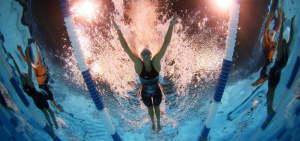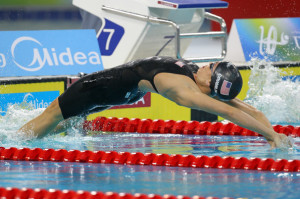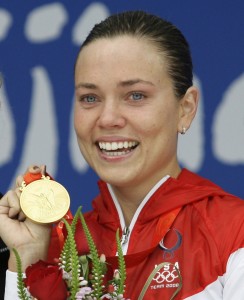Hello swimming enthusiasts!
In a few days, Natalie Coughlin, along with a large group of foreign swimmers, will compete at the Canadian Olympic Trials in Toronto. The meet, taking place from April 5-10, has become not only a competition to select Canadians for the Olympic and Paralympic Games, but also an international competition for many North American swimmers. In some cases, these foreign swimmers come from countries without real Trials or with flexibility in qualifying for the Games. For NCAA swimmers, the Trials serve as a helpful long course test after the NCAA competition. In addition, many teams have started to travel to the competition as a group, for a great training meet.
With the exciting competition around the corner, today I will give you a closer look at Natalie Coughlin. Coughlin was born in 1982 in Vallejo, California, and began swimming competitively at the young age of six. By the time she was a high schooler, Coughlin reached national recognition. She held the national high school records in the 200-yard IM and 100-yard backstroke, and at the age of sixteen, she qualified for every event at summer nationals. Her ability to qualify for every single event surely displays her incredible skill and expertise in all things swimming.
Coughlin attended college at the University of California, where she shined as a swimmer under the guidance of her coach, Teri McKeever. In 2002, she became the first woman in history to achieve a time under one minute in the 100-meter backstroke. Over the course of her college career, she won 12 NCAA titles. Today, Coughlin is still Cal’s most decorated swimmer of all time, and holds records in the 100 freestyle, 100 backstroke, 200 backstroke, 100 butterfly, and 200 butterfly.
Coughlin’s international career began at the 1999 Pan Pacific Championships. She has had immense success at the international level, winning medals and setting American and World Records at meets such as the 2001, 2007, and 2013 World Championships.
However, Coughlin is perhaps best known for her Olympic success. At the 2004 Trials, she qualified for the Olympic Team in the 100 backstroke and 100 freestyle. She was the woman to watch in the 2004, 2008, and 2012 Olympic Games. After winning twelve Olympic medals, she is tied with Jenny Thompson and Dara Torres as the most decorated American female swimmer.
Coughlin has faced several challenges over the course of her swimming career. She has scoliosis, a 27-degree spinal curve, something that she must be very careful about when she approaches the racing season. In addition, she feels that she is often much shorter than her competition–she is 5’8’’, while many of her competitors are over six feet. This is particularly an obstacle for her in shorter races. Coughlin does, however, have many advantages in the water. For example, she is very flexible–she can touch her toes with her elbows. In addition, she has long arms. While she is only 5’8’’, her reach is 6’1’’.
Coughlin is constantly experimenting with her stroke. In the past, she has rotated a lot throughout her whole body, but more recently, she has focused on rotating specifically in her upper body to generate more power in her arms. Coughlin’s talent, perseverance, and versatility in the pool make her a shining example of women in swimming.
Sources
https://swimswam.com/nathan-adrian-to-compete-at-canadian-olympic-trials-psych-sheets/
https://swimswam.com/bio/natalie-coughlin/
http://wtop.com/sports/2015/02/us-swimmer-natalie-coughlin-to-lead-strong-team-at-pan-ams/
Photos
http://www.zimbio.com/photos/Natalie+Coughlin/10th+FINA+World+Swimming+Championships+25m/GvnHCVpM8uM
http://www.teamusa.org/news/2012/june/27/natalie-coughlin-still-has-hope
http://www.sandiegouniontribune.com/sdut-us-swimmer-natalie-coughlin-to-lead-strong-team-2015feb13-story.html



